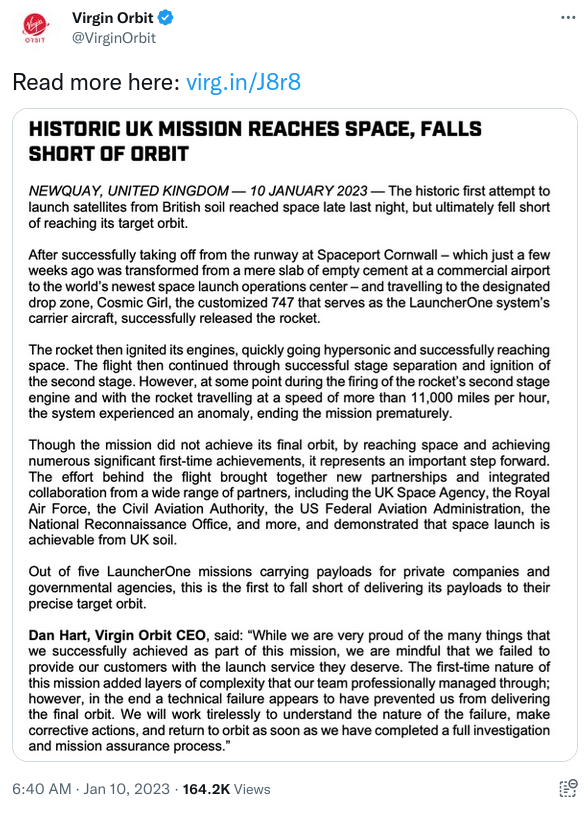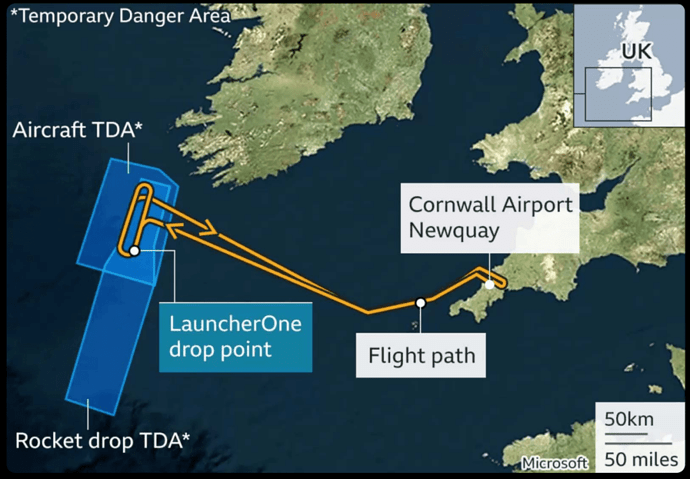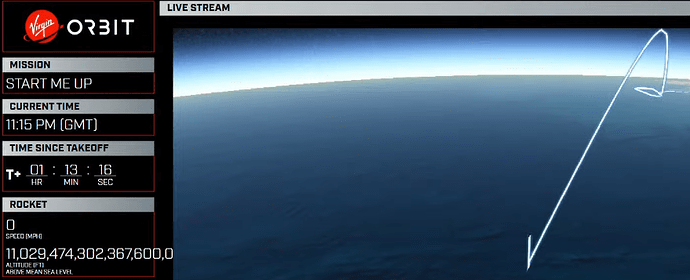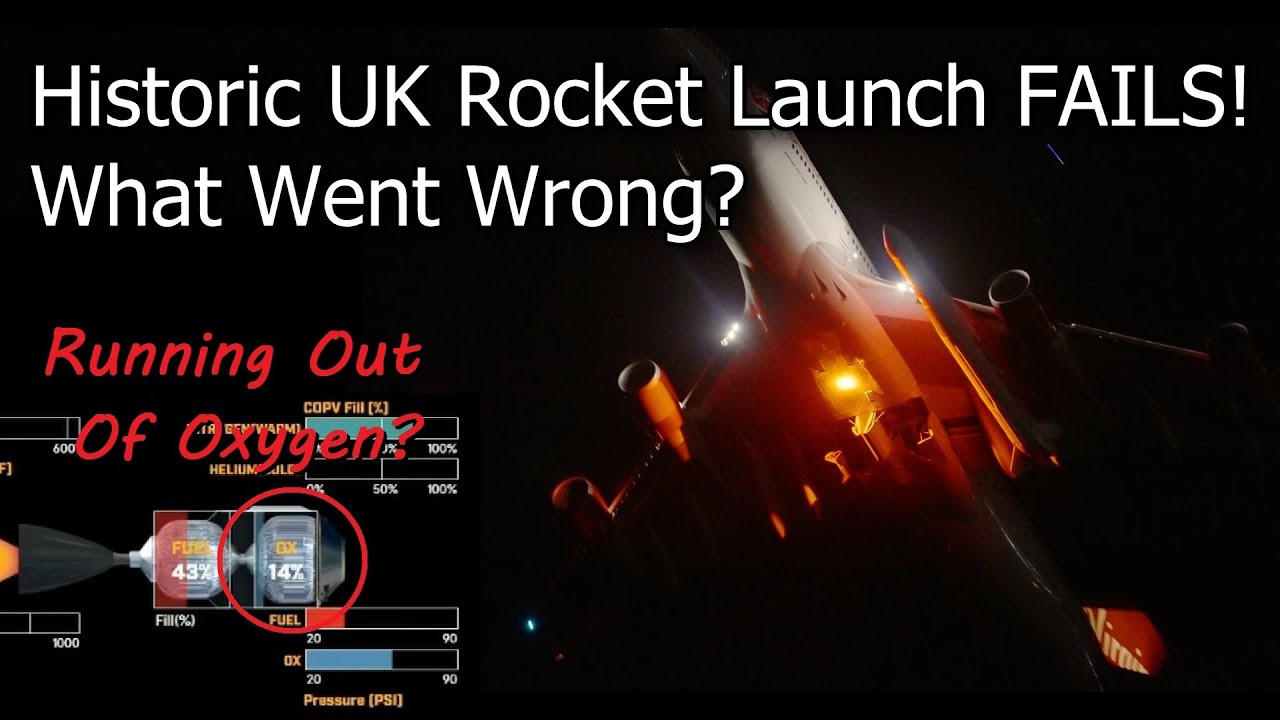After a successful air drop and apparently normal first stage burn, the launch failed with an “anomaly” during the second stage burn that resulted in the launcher failing to reach orbit. The payloads, or what’s left of them after falling back into the atmosphere on a steep suborbital trajectory, splashed into the Atlantic. Virgin Orbit released this statement.

Jeff Foust of SpaceNews has more details, including the possible financial consequences for Virgin Orbit, “First Virgin Orbit U.K. launch fails”.
The aircraft flew to its designated drop location over the Atlantic Ocean off the southern coast of Ireland and released the LauncherOne rocket at approximately 6:11 p.m. Eastern. While telemetry during the live webcast of the launch was unreliable, reporting what appeared to be spurious speed and altitude figures at times, the company reported seven minutes later that the rocket’s upper stage and payloads had reached orbit.
“LauncherOne has once again successfully reached Earth orbit!” the company announced in a tweet it later deleted. “Our mission isn’t over yet, but our congratulations to the people of the UK! This is already the first-ever orbital mission from British soil – an enormous achievement by @spacegovuk and their partners in government!”
The launch then appeared to be in a coast phase before a second burn of the upper stage’s NewtonFour engine, followed by payload deployment. But nearly a half-hour after the announcement of reaching orbit, the company suddenly revealed the launch had instead failed.
“We appear to have an anomaly that has prevented us from reaching orbit. We are evaluating the information,” the company announced. The company provided no other information about the anomaly, including at what state of flight it took place and why the company incorrectly reported reaching orbit. It did confirm that that the Boeing 747 had landed safely back at Spaceport Cornwall.
⋮
The failure comes at a precarious time for Virgin Orbit, which has struggled to increase its launch rate and generate revenue. The company, in a Nov. 7 earnings call, reported it closed the third quarter with $71 million in cash, after reporting negative free cash flow of $52.5 million. The company raised $25 million from Virgin Group in early November and another $20 million from Virgin Investments Limited, an investment arm of the Virgin Group, Dec. 20.
The livestream of the launch (replay included in the original post) approached Soviet levels of transparency. The first indication that the rocket had been dropped was at 1:54:59 where the view cuts to the aft camera on the rocket, showing the first stage burning. Launch telemetry does not start until 1:55:35, when it shows the rocket at 2,618 mph and 115,771 feet altitude (the commentator noted “in the aerospace industry, Imperial units are used). The flight continues with a musical soundtrack and the plume seeming to expand, with telemetry shoring smooth acceleration and ascent. At 1:56:47 they cut away to the vehicle status page, which shows propellant in the first stage almost entirely depleted. The announcer then reports main engine cutoff as normal. For a few seconds, the speed continues to increase, presumably indicating the second stage is firing, but there is no indication of this on the status page.
At 1:57:17 the reported speed jumps from 8,029 mph to 4,041,268,212 mph, which is about 2.5% the speed of light. Presumably this is due to ratty telemetry, unless they’ve engaged warp drive. At 1:57:30, the screen cuts to the aft camera view and telemetry now reports speed as 8.202 mph as Sulu appears to have taken his lead foot off the accelerator. Then, at 1:57:39, speed jumps to 79,104,435,116,891,760,000 mph, which 1.18\times 10^{11} times light speed, and a few seconds later we return to speeds in the 8000 mph range, continuing to accelerate. The commentator speaks of “dropouts in the data as we are switching between different ground stations”. But, certainly, they must have checksums on the digital data downlink to avoid transmission errors causing absurd results, don’t they? Don’t they?
Next, at 1:57:49, we cut to a forward camera view which shows what, with a little imagination, you can see might be payloads exposed after fairing jettison, illuminated very weakly by the engine plume of the second stage engine. Well, maybe it takes more than a little imagination. The telemetry now reports the speed as 8425 mph and altitude as 0. Speed then jumps to 0 mph.
At 1:58:12 the forward camera view is replaced by the trajectory plot, showing the rocket proceeding southward from the launch location. Speed and altitude are now both zero. Telemetry then returns at 9,110 mph and 506,907 feet. The status page then returns, showing the second stage burning with fuel at 77% and oxidiser at 56% and the engine gimbal centred. Velocity jumps around, but seems to be overall increasing. The launch control centre continues to report nominal stage two burn and trajectory.
At 1:59:59, velocity jumps from 11,358 mph to 4,568,515,429 mph, then to 9,015, and back to 11,602 mph, and shortly thereafter to 0 mph, at which point altitude jumps from 596,392 feet to 988,656 feet instantaneously (did somebody just cut in the Sarfatti metamaterial drive?) The trajectory plot then shows an abrupt, UFO-style right turn toward a vertical climb. Next, we’re back at 599,170 feet but zero miles per hour. While remaining at zero speed, altitude then jumps to 11,029,474,302,367,600,000 feet, which is 335 light years, a tad more than the distance to the bright star Canopus. Then we’re back closer to home at 794,062 feet, still at zero velocity. The trajectory plot continues to show a vertical rise.
Cut back to the status page, which now shows fuel at 31% and oxidiser at 0% and the engine gimbal near limit toward the bottom. Engine gimbal starts jumping around as if the rocket has gone all Kerbal with Jeb asleep at the controls, while fuel magically jumps back to 50% and oxidiser 15%. As this is happening, speed remains at 0 mph, but altitude reports −2,212 feet. The browser showing the status display then crashes and is replaced by a Virgin Orbit logo.
The trajectory plot returns, showing a continued vertical climb. Altitude shows crazy jumps updating around once per second. There is then a call that sounds like “Newton 4 [second stage engine] shutdown initiated”. Shortly after, the rocket telemetry freezes at 0 mph and 244,030 feet.
There following a long musical interlude with views of the Cornwall coast and the mission logos, with occasional open microphone interjections. At 2:22:42, the commentator returns and claims the rocket is now in stage 2 coast, presuming it to be in orbit. At 2:30:05, the announcer returns to say “LauncherOne has suffered an anomaly which will prevent us from making orbit”. At 2:38:20 the carrier plane returns and lands. The live stream ends at 2:52:45 without another word on the status of the rocket.



